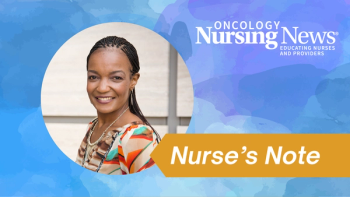
- June 2015
- Volume 9
- Issue 5
Navigating Pregnancy and a Breast Cancer Diagnosis
If you meet a patient who is pregnant with a breast cancer diagnosis, a nurse navigator is invaluable, and there are many important considerations.
Eleanor Miller, RN,
MSN, OCN, CBCN
What do you do when you are enjoying one of the most exciting times in life with a new baby on the way and then WHACK—you are diagnosed with breast cancer during pregnancy? How do you even get your head around this situation? This was supposed to be a happy time of anticipation, selecting paint colors, planning baby showers, and choosing names—not which oncologist to see or deciding what surgery to have which may limit your ability to breastfeed.
While uncommon, this reality does exist. Pregnancy and a breast cancer diagnosis each come with their own set of emotions and physical changes; combine them and these women and families find themselves in great need of support: Enter the nurse navigator whose role here is paramount. If you meet a patient who is pregnant with a breast cancer diagnosis, a nurse navigator is invaluable, and there are many important considerations.
Asking the Right Questions
- How far along is the pregnancy?
- Does the woman want to be pregnant?
- How did the breast cancer diagnosis come about?
- What workup has she had so far? Mammography may be needed to evaluate extent of disease (and safe with shielding).
- What has she been recommended thus far?
- Does she need to see a surgeon first for initial evaluation/second opinion, a medical oncologist, or both?
- What are the woman’s surgical goals?
- What family or social support does she have?
Oncology appointments need to be coupled with maternal fetal medicine (MFM) and/or family planning to plan out the timeframe of the care plan, usually week-by-week. Neoadjuvant chemotherapy may be recommended to get a woman to delivery, followed by surgery. We can’t give chemotherapy too close to delivery due to infection risk and to avoid a nadir at delivery.
Alternatively, and depending on the treatment plan, the mother may be recovering from surgery or receiving chemotherapy and trying to care for a newborn at the same time. These are all considerations for providers and patient, and a nurse navigator can help to reinforce the recommendations. We can help weigh options and give insight into what the process is for chemo-therapy, side effects, or surgery and recovery. While we don’t make the decision for the patient we can certainly answer questions and give women things to think about: Will she have help at home? Are there other children? Is her family complete? How can she best plan ahead? What does her ongoing care look like?
Becoming Pregnant During Treatment
What happens when a woman is already being treated for breast cancer and becomes pregnant?
I met Melanie, a 31-year-old mother of two young girls, during her first breast cancer diagnosis. She was referred to me for additional support and guidance throughout her treatment. Her surgeon recommended neoadjuvant chemotherapy for her stage III cancer, which usually warrants a navigator’s involvement due to many initial needs and decisions to make early on in care. At the time, she was separated from her husband and had limited support, but did live with her mother and brother. Much of her other family was in Ethiopia, but at various points in time her aunt or cousin would come to the United States to help. She had previously worked as a hairstylist but had stopped working when she was diagnosed.
Melanie had a few lapses in medical assistance throughout her care, and her only source of income was child support. As a navigator collaborating with our social workers, we were able to get her the insurance coverage she needed to receive her treatment, as well as apply for some financial grants to help defray some costs.
Once she finished chemotherapy, Melanie had a decision to make about what surgery to have: unilateral or bilateral mastectomy, and autologous or implant-based reconstruction. We spoke at length and over the course of a few weeks about her surgery options. She was worried about her recovery time and caring for her children as well as her own health and risk reduction. How quickly could she get back on her feet? Would she be able to lift her girls? How will they react? Who will bring her back for appointments if she can’t drive? Ultimately, she chose a bilateral mastectomy with flap reconstruction after a last-minute change in her prior decision for implant-based reconstruction. She recovered from her surgery as expected and started on tamoxifen therapy.
At this point, I hadn’t had much contact with her since things were going well. About 9 months later, she developed hip metastasis and stopped tamoxifen. She declined additional endocrine therapies due to her feeling that because her treatments didn’t work the first time, why should she do more?
Fast forward a few more months and I received a call from her oncologist asking me to come to clinic to attend her appointment. Melanie was newly pregnant. She had metastatic breast cancer. My initial thought was, “who was the father?” since the last I had heard she was separated from her husband. They had reconciled, and even with contraceptive counseling from her oncologist, she still became pregnant. What to do now?
A team was quickly mobilized with oncology, family planning, and MFM. We were able to get her seen by all of the providers to help her gain information about her options. Should she terminate the pregnancy or does she keep the baby? Time was of the essence in her decision in order to support her health and that of her baby. I’ve always been proud of my ability to handle tough situations as a nurse, but what do I say to a woman who is not only my age and pregnant but has metastatic breast cancer? I was at a loss for words. She knew me well and was not looking for answers from me, rather just support, so in hindsight I think my silence was okay, and she knew I cared.
We walked out of the appointment together, and I gave her my arm because she couldn’t walk very well. She looked at me and just said “Can you believe it?” Not very emotional, not angry, not upset, just very matter-of-fact. At first I wasn’t sure she comprehended the severity of the situation. I was wrong. She heard everything. She was as thoughtful about her decisions as she had been since the beginning, not as outwardly emotional as many of my other patients. Her steadfast faith was about to become much more evident and relied upon.
Weighing the Options
After meeting with the various providers, I spoke with her to offer her more support. She weighed her options and was trying to be realistic. She didn’t know how to make this decision and couldn’t ask some of the people in her life because of their own beliefs and biases. Either way, she had risks: risks of her cancer worsening with no treatment, limited ways to manage her pain and also potential risks to her baby. As a team, we reinforced to her that either decision would be supported by us, and there would be no judgment. Ultimately she chose to keep her baby. I’ll never forget what she said to me about her decision. “The pain of not having the baby will be worse than any cancer pain.” The team supported her decision.
A plan was quickly formulated to offer her supportive care and symptom management as well as support her pregnancy. Pain management was involved to help with medications. MFM monitored her pregnancy, and her oncology team worked to coordinate all of the efforts. She was in and out of the hospital for pain management and fluids throughout her pregnancy, and home care was provided to help support her needs at home.
At 28 weeks, Melanie delivered her baby boy, by C-section, at a healthy 5 pounds, probably with a bit of the help from the steroids she was taking. He had a NICU stay because he was premature but otherwise no problems. She chose a name meaning “God will get you through it.”
Close to her discharge from the hospital, her nursing team threw her a party. She was going to go home on hospice and hopefully get back to Ethiopia. The cake the nurses bought her said, “You inspire us.” My patient made it back to Ethiopia for a month and was able to return to the states. She lived about 5 more months and died peacefully at home.
Our work with our patients naturally brings us close—to some patients more than others. Our experience teaches us many lessons: in this case, the value of collaboration, navigation, and the grace of a patient in the face of a unique and challenging situation were ever present. As nurses, some patients’ stories endure. This one will stay with me forever. Yes, Melanie, you continue to inspire us. Thank you for that.
Eleanor Miller, RN, MSN, OCN, CBCN, manages the navigation program at the Abramson Cancer Center of the University of Pennsylvania in Philadelphia. She has been a nurse for 8 years, all spent in oncology, and an oncology nurse navigator for over 3 years, serving multiple specialties. Her work includes multiple process improvement projects to improve access to oncology care. Miller has spoken at local and national conferences about her projects and serves as a clinical preceptor for graduate nursing students. She was nominated and completed the PENN Futures Program which identifies and trains future healthcare leaders.
Articles in this issue
over 10 years ago
Managing Immune-Related Toxicities: Q & A With Dr. Michael Postowover 10 years ago
For Patients With Cancer, Web-Based Portals Can Inform and Empowerover 10 years ago
Immunotherapy-Transforming Cancer Care, Offering Patients New Hopeover 10 years ago
Preparing for the Unexpectedover 10 years ago
Where Are the Men? The Impact of BRCA in Prostate CancerNewsletter
Knowledge is power. Don’t miss the most recent breakthroughs in cancer care.
















































































